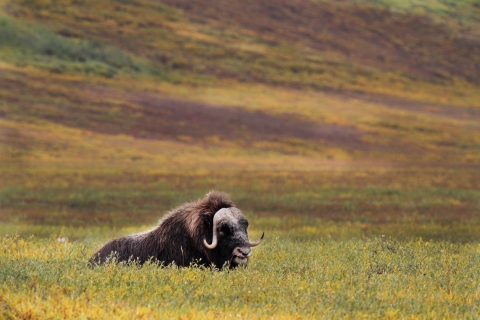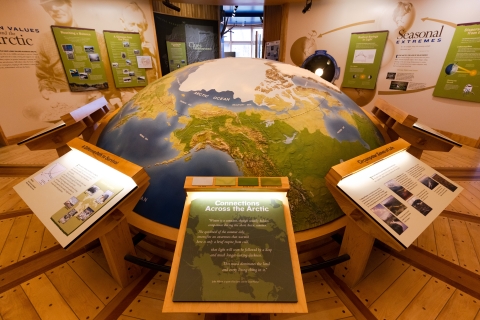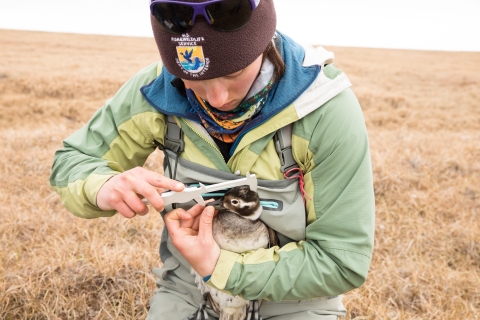What We Do
Wildlife conservation is at the heart of the National Wildlife Refuge System. It drives everything on U.S. Fish and Wildlife Service lands and waters managed within the Refuge System, from the purposes for which a national wildlife refuge national wildlife refuge
A national wildlife refuge is typically a contiguous area of land and water managed by the U.S. Fish and Wildlife Service for the conservation and, where appropriate, restoration of fish, wildlife and plant resources and their habitats for the benefit of present and future generations of Americans.
Learn more about national wildlife refuge is established to the recreational activities offered to the resource management tools used. Using conservation best practices, the Refuge System manages Service lands and waters to help ensure the survival of native wildlife species.
Arctic Refuge management activities focus on stewardship of wildlife and landscapes, preserving their wilderness values and ensuring the extraordinary public uses available at the refuge can continue. The range of arctic and subarctic ecosystems within the refuge, from boreal forests to alpine tundra, arctic coastal plain, and the arctic coast, support a diversity of plants and animals. Biologists conduct surveys to determine distribution and population trends for several wildlife species. Researchers study plant communities and snow conditions to monitor changes over time associated with disturbance and climatic conditions.
The refuge has management responsibility for subsistence hunting by residents of rural villages. Information from surveys of caribou, muskoxen, moose, and Dall sheep supports recommendations for open seasons and allowable harvests.
Management and Conservation
Refuges deploy a host of scientifically sound management tools to address biological challenges. These tools span active water management to wilderness character monitoring, all aimed at ensuring a balanced conservation approach to benefit both wildlife and people. At this field station our conservation tool box includes:
- biological research,
- compatibility determinations,
- cultural resource oversight,
- education and outreach,
- fire management,
- human dimensions studies,
- inventory and monitoring,
- law enforcement,
- recreation management,
- Wilderness character monitoring,
- and Wild and Scenic Rivers Wild and Scenic Rivers
The Wild and Scenic Rivers Act of 1968 established the National Wild and Scenic Rivers System, and authorizes Congress to preserve certain rivers with outstanding natural, cultural and recreational values in a free-flowing condition for the enjoyment of present and future generations. The act is notable for safeguarding the special character of these rivers, while also recognizing the potential for their appropriate use and development. The act encourages river management that crosses political boundaries and promotes public participation in developing goals for river protection.
Learn more about Wild and Scenic Rivers management.
Comprehensive Conservation Plan
Each Refuge's main planning document is called a “comprehensive conservation plan” (CCP). The Arctic Refuge's first CCP was published in 1988. The Revised Arctic National Wildlife Refuge Comprehensive Conservation Plan and Final Environmental Impact Statement was finalized on April 3, 2015. The revised plan describes six alternatives for Refuge management and assesses the effects of implementing each of the alternatives. The agency’s decision adopts as its preferred choice Alternative E. Alternative E recommends the three Wilderness Study Areas be designated as Wilderness and recommends four rivers for designation as Wild and Scenic Rivers. The Revised Arctic Refuge CCP is published in four volumes: 1) an introduction, 2) appendices, 3) comment analysis, and 4) sample of public comments. Each chapter of volumes 1 and 2 are available below. Contact Arctic Refuge if you'd like information about these or about the other two volumes of the CCP.
Revised Arctic National Wildlife Refuge Comprehensive Conservation Plan (2015):
Volume 1:
-- Cover and Front Pages
-- Chapter 1. Introduction
-- Chapter 2. Goals. Objectives, Management Policies, and Guidelines
-- Chapter 3. Issues and Alternatives
-- Chapter 4. Affected Environment
-- Chapter 5. Environmental Consequences
-- Chapter 6. Implementation and Monitoring
-- Chapter 7. Literature Cited
-- Errata Sheet for Vol 1.
Volume 2:
-- Volume 2 Cover and Front Pages
-- Appendix A. Legal, Policy, and Planning Guidance
-- Appendix B. Consultation and Coordination with Others
-- Appendix C. Other Planning Efforts
-- Appendix D. Issues Considered but Eliminated from Detailed Study
-- Appendix E. Easements, Rights-of-Way, and Withdrawals
-- Appendix F. Species List
-- Appendix G. Appropriate Use and Compatibility Determinations
-- Appendix H. Wilderness Review
-- Appendix I. Wild and Scenic River Review
-- Appendix J. Public Scoping Comments
-- Appendix K. Mailing List
-- Appendix L. Preparers of the Plan and Planning Team Members
-- Appendix M. Glossary
-- Errata Sheet for Vol 2.
-- Index for Volumes 1 and 2
The full volume 1, as a single large file (67 MB):
Our Services
Special Use Permits
Arctic Refuge is open to the public year-round. No permit is required if you are visiting the Refuge on your own as a member of a private recreational group. A Special Use Permit is required if:
1) You conduct a commercial activity such as guiding or providing commercial transportation; or
2) You propose to conduct scientific or geological research or other non-recreational activities.
Note that Arctic Refuge has established application periods for the following types of Special Use Permits:
- Commercial Activities: There are two applications periods – January 1 until April 15 and October 1 until November 30.
- Scientific Research Activities: October 1 until November 30 (for activities proposed the following calendar year).
Other Activities Requiring a Special Use Permit: Applications may be submitted at any time.
Follow this link for complete application information about Special Use Permits at Arctic Refuge.
If you have questions about special use permits at Arctic Refuge please contact Permits Specialist Maria Berkeland at arctic_permits@fws.gov or at 907-456-0512.
Other Services
The refuge does not provide facilities or services within the refuge boundaries.
Additional services are available outside the refuge and information is provided via web or contacting refuge staff: (907) 456-0250 and arctic_refuge@fws.gov.
Visitors may also explore exhibits and information resources at the Arctic Interagency Visitor Center in Coldfoot, Alaska:
907-678-5209 or 678-2015 (open late May to early September),
and at Alaska Public Lands Information Centers:
Anchorage: 907-644--3680, anch_web_mail@nps.gov;
Fairbanks, 907-459-3730, fair_information@nps.gov).
Our Projects and Research
Arctic refuge staff collaborate with partners, organizations, communities and other U.S. Fish and Wildlife Service programs to monitor and research the ecological systems and diversity of wildlife in this far northern landscape. Current and recent projects include:
- Inventory and Monitoring Plan activities
- Monitoring and researching migratory birds that breed and nest on the arctic coastal plain
- Aerial moose population surveys
- Moose research on the north slope and coastal plain
- Caribou spatial ecology and migration research
- Dall sheep surveys
- Arctic fox investigations
- Snow surveys
- Fisheries research
- Wetlands inventory
- Hydrological monitoring
Law Enforcement
Contact Senior Federal Wildlife Officer Cody Smith at 907-385-7660 if you would like to speak to a Law Enforcement Officer about an issue at Arctic Refuge. If you want to remain anonymous, you can contact our National Tips Line at 1-844-FWS-TIPS (1-844-397-8477).







